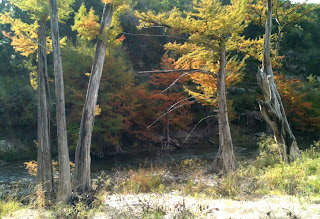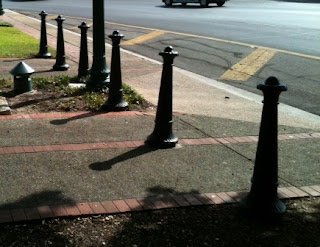He is not only a professional photographer but a window-cleaning professional as well. My friend, whom I had not seen in quite some, time stopped by unexpectedly and we shared some truly enriching conversation. His unusual mix of creative and practical work always brings an interesting perspective to our conversation.
The two hours that we spent yacking (or is that "yakking?") covered a lot of ground and of course we solved many of the world's ills in the process. One thing that came up was the intriguing interplay between individuality and community in creative pursuits.
As an artist it is always obvious how personal the act of creating is. It is about taking something that is very significant personally, and expressing it. It is about taking something internal, hidden, and owned, and making it external, visible, and in a sense, giving it away. Art always starts with an individual personality who values something deeply. It always starts with some one.
 |
Frozen Mustang Grapes—
Turning them into wine, the project at hand
© Bill Brockmeier, 2012 |
If anything is to happen creatively an artist must initiate– he must seize those nuggets of inspiration and take a risk. The artist has to act, or risk losing those glimmers of what might have been.
If I have learned anything about photography (and art in general, for that matter) you can't see something and then say to yourself– "Wow...that would make a great shot! I'll have to remember to come back to that when I have time tomorrow..." No, you'd better at least attempt to take a great shot of it now, as tomorrow will, most likely, never come. If inspiration strikes, the moment needs to be seized, or the moment (and the art that accompanies it) will be lost. This is the personal prerogative of the artist, and he can blame no one else if he let's the potential creation slip away. The inspiration comes in a personal way, and the person is responsible to act on it.
As our conversation continued, we began to discuss the fact that art and its creation is not entirely individual and personal, but is also a function of community. I have already indirectly referred to this communal aspect when I mentioned above that the internal, personal creation must ultimately be given away. Yes, this giving away is a personal act, but obviously it must have an object; there must be someone to whom it is given. Without some audience, without someone to see, hear, feel, or otherwise evaluate and appreciate the creative work, this art is simply a masturbatory excercise. If the art remains a personal thing and doesn't connect with another, it remains pointless and empty– sterile.
And the importance of human relationship to art is not only that someone is out there to receive it. Our ability to "speak" creatively to the community is not simply a one-way street, for if we only ever spoke, and never listened, this, too, would end up being empty. We have ears to listen, and eyes to see, and we need to be taking into our personal, internal beings what others are communicating to us (whether those others be artists or not).
As my friend and I conversed, I was reminded of some experiences of several years ago. A co-worker, who happens to be both a jazz saxophonist as well as a mechanical designer, was commenting one day on some of my photographs. He spoke in some detail about all of the things he was seeing in my work– geometric relationships in the composition, the emotional ground and tone of the images, and so on. I had to admit to him that I hadn't really seen some of these things before in my own work, and, frankly, I was amazed that these things were there. That simple interchange caused me not only to see those things in my past work, but to actually look for them in the world around me so I could consciouslly strive to incorpororate them into new work. And it also causes me to now look (and appreciate) much more deeply the work of other artists.
The direction of the conversation that my friend and I had been pursuing began taking another turn. We realized that so much of what were talking about was incredibly parallel to what we both know of true spiritual community. He and I have known each other for many, many years, and before we ever shared common interests in photographic pursuits, we knew each other as spiritual "brothers." In true, Christian spiritual community, the term "brother" is not merely a cliche to be thrown around trivially, but is a vital truth of our existence. And it is in this sense that we began realizing the dual, two-track nature of our conversation.
Just as with the artist, the creative act begins for our spiritual nature as an intensely personal thing. These "things" rise up within us, striving and yearning to make it to the surface, struggling to burst out of us and become external realities. These "things" are the "creative," spiritual acts that are generated, not by us, but by the Holy Spirit of the Creator Himself– God Almighty actually living in us, and in some miraculous, incomprehensible way, through us.
And just as with the artist, we believers have a choice before us. We can either respond by saying "Wow, that was a great inspirational thought or understanding or impulse...I'll act on that when I have more time tomorrow...," or we can choose to actually act on it and say "Wow...there is no time like the present...in fact, there IS NO TIME BUT THE PRESENT! I will take a hold of that inpiration and flesh it now to the best of my ability, for there may not be any further opportunity to act on this. Thank you Lord!"
The interesting thing of this is that even in this intensely personal act, it begins not actually with us, but with another– the One Who is the ultimate Creator! We simply need to respond to His creative impulse, so even in this we have community and relationship at work.
But then, there are the more obvious relational aspects of the spiritual life– the "brother"-liness (and sister-liness) that I mentioned above. Just as with the creative expression of an artist, the true spiritual person aims for her life to connect with others, for her spiritually creative impulses (initiated by the Spirit of God) to impact the lives of other people. If we sit on these "things" and don't let them see the light of day, they are pointless, void, and sterile. We need to seize these nuggets of inspiration and breathe life into them by breathing them into others' lives.
Finally, my "brother" and I agreed that the other direction of relational life is just as important for our spirits as it is for the artist. To listen intently to others, to try to see what they are trying to show us is essential for our lives. It is essential for a properly balanced view of ourselves, as well as for an accurate view of others. We seriously need to cultivate and attune our receptive skills. The musician calls this intonnation, and he values this as one of his most important attributes– the ability to listen carefully and precisely to the other players in the ensemble, so he can effectively "play in-tune" with them and thereby produce powerful and beautiful and timeless music that can take the breath away.
He had to leave, and I had to finish the project I was working on, so we parted ways that day, both the richer for it.
Don't make the mistake of waiting for "just the right time" to act on creative impulses: either artistic or spiritual. And don't make the mistake of thinking that artistic pursuits or spiritual life are only singular, personal pursuits. Live in the community as well as your own skin, and your life will certainly be the richer for it.
























.jpg)
.jpg)











